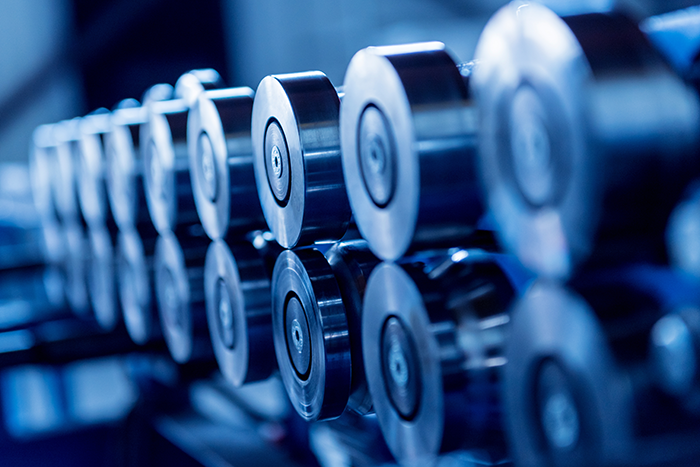Custom Roll Forming for Complex Profiles
Learn more about the various types of complex profiles in rolling forming and what tooling and techniques are needed to achieve precision.

Learn more about the various types of complex profiles in rolling forming and what tooling and techniques are needed to achieve precision.

Roll forming is a highly relied-on manufacturing method for creating complex profiles with strict tolerances. In roll forming, each roll stand progressively shapes the metal tube closer to the desired profile, allowing continuous production. The more stands there are, the more complex the profile can be.
In this article, we’ll cover how roll forming is used to create common complex profiles, including U-channels, box channels, multi-bend, custom cross-sections, and more.
As the name suggests, U-channels have a distinct U-shaped cross-section. This type of profile is commonly used in framing systems, tracks, and structural supports in various industries. What makes this profile so complex is the need to maintain precise dimensions, even along the bends and flanges.
Achieving a U-channel profile requires roll forming tooling, including bottom rolls, side rolls, edge rolls, and cut-to-length tooling, that can manage the subtle bends and ensure uniformity across long production runs.
C-channels have a C-shaped cross-section and are indispensable in frameworks requiring strength and rigidity, such as vehicle frames, building structures, and support beams. Roll forming C-channels can be challenging because exact curvature and depth control are needed. Specialized tooling is required when creating C-channels, as well as advanced monitoring and control systems to help maintain precision.
Z-channels are commonly found in metal building systems, wall supports, and roof joists. Its alternating flange orientations are complex, requiring precision in bending angles and depth to ensure symmetry and structural performance. Roll forming these types of profiles requires specialized tooling, including base rolls, first bend rolls, second bend rolls, and edge rolls, that can accurately shape the metal into a Z-profile.
Forming rolls specifically designed to accommodate the alternating flange orientations are also essential, along with gauging equipment, to ensure the correct depth and angles are achieved consistently throughout the production run. The tooling must also be strong enough to handle the stresses involved in bending the material into a Z-shape without compromising the material’s integrity.
V-channels are commonly used in conveyor systems, drainage channels, and construction framing and can be complex in roll forming because they require an acute angle along the fold line. This angle is crucial for applications that require efficient material flow or accurate alignment.
As with all profiles, V-channels require specialized tooling, including V-dies. High-tolerance backstops and gauging systems are also needed to ensure the angles and dimensions remain consistent throughout the process.
Hat channels incorporate horizontal flanges and a vertical web. They are essential in construction, particularly for providing rigidity and stability in framing and support in walls and ceilings. Because precise alignment and uniformity are needed in the flanges and web to ensure structural integrity, high-precision alignment tools, automated measuring systems, and custom-designed tooling and dies are often used in roll forming.
Box channels have closed, rectangular profiles, making them one of the most complex shapes to produce through roll forming. All four sides must be uniform and straight to ensure they perform well in their intended applications, such as automotive frames and heavy machinery. Roll forming these types of profiles requires advanced, multi-stage tooling that involves both pre-forming and final shaping dies, along with accurate, computer-controlled bending and cutting equipment.
Multi-bend profiles, often seen in window frames, automotive structures, and intricate machinery components, require highly accurate coordination in the roll forming process. Generally, there are sequential roll stations, each tasked with a specific bend. Tooling must include multi-stage dies designed to perform consecutive bending operations without compromising the metal’s integrity or dimensions and computerized control systems to maintain accuracy and repeatability.
Lastly, profiles with variable widths and thicknesses can often be found in automotive and construction applications, such as beams and columns, where changing dimensions can optimize material use and structural performance. They’re complicated to produce because the dimensions change along the length of the profile. Roll forming variable-section profiles usually means creating adjustable or multi-faceted tooling that can accommodate the different sections as the profile changes along its length, as well as advanced feeding mechanisms, alignment systems, and control systems that allow for dynamic and sometimes real-time adjustments.

The important takeaway is that precision is critical. No matter how complex profiles are, roll forming manufacturers must guarantee dimensional accuracy and adhere to tight tolerances. Because many of these complex profiles are used in automotive and construction applications, any deviations or defects can lead to serious risks.
At MMC Roll Forming, we ensure quality and precision by using advanced roll forming technology. Our state-of-the-art facility features 14 roll mills, allowing us to handle up to 21 pass sequences. We also have a vast inventory of specialized tooling to produce the complex profiles mentioned in this article, along with pre-pierced components and precise cutoff and notch features.
Visit our website to learn more about our capabilities, or contact us today to request a project analysis.